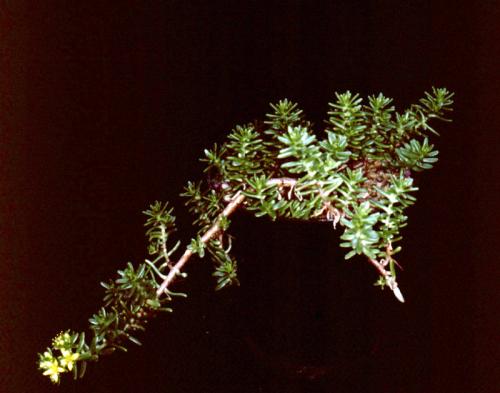RUWENZORIENSE Baker fil., 1908
Synonyms :
Sedum ducis-aprutii Cortesi (1908)
Sedum kiwuense Anonymus in sched. ex Hamet (1929)
Distribution : Ethiopia, Kenya, Uganda, Rwanda, Sudan, Zaïre, generally on rocks, 2400 - 4500 m.
Description (according to IHSP, 2003) :
Glabrous perennial herbs with erect or decumbent branched papillose stems to 20 (-30) cm, often distinctly woody at the base.
Leaves alternate, often densely imbricate, sessile, oblong to oblong-ovoid, 5 - 20 x ± 3 mm, obtuse, semiterete, sometimes papillose, bright green or reddish.
Inflorescences bracteate cymes or corymbs with 3-4 cincinni, these sometimes forked, bracts 2 per flower, pedicels 1 - 4 (-6) mm.
FIowers 5-merous, sepals basally free, spurred, 1,5 - 2 mm, obtuse, petals basally connate for 0,2 – 0,4 mm, oblong-lanceolate to oblong, 4 - 6 mm or longer, bright yellow, filaments 2,5 - 3 mm, yellow, anthers 0,6 - 0,8 mm, yellow.
Closely related to S. meyeri-johannis.
Ray Stephenson (Sedum, Cultivated Stonecrops, 1994, pp 192-193) :
Sedum ruwenzoriense is the only true East African Sedum in general cultivation, but its fickle nature makes it exceedingly rare. As a high-altitude alpine, it is most difficult to perpetuate in cultivation. Bushy little plants resemble S. japonicum [= S. uniflorum ssp. japonicum] in form but can attain 15 cm (6 in) in stature. Lower stems are quite sturdy and bare. Upper halves of stems have light green patent, slightly spurred, long-elliptic leaves in loose spirals. A few pale yellow flowers are produced in spring.
Habitat : Mount Ruwenzori, Mount Kenya, and adjacent peaks from 2300 to 4000 m (7500 to 13000 ft) are the home of this equatorial alpine. Often it grows as an epiphyte.
Main points of distinction : The general appearance of this stonecrop is somewhat distinct. Very large, free, spurred sepals are good proof of identification. Like the leaves, which are flat on both surfaces, sepals are somewhat papillate at their tips (Leaf shapes fig. 4g).
Variation : Probably the few plants in cultivation have all been propagated from the same stock, but it seems more than feasible that différent clones do exist, as there are disjunct sites in the wild.
Horticulture : Unfortunately, hailing from such high-altitude origins, Sedum ruwenzoriense
detests hot greenhouse conditions. Once part of a plant bakes, the rest of it slowly dies and refuses, in any way, to be propagated. Plants can stand lots of frost if bone-dry but are best kept in a cold frame, which is cool in summer. It is essential to give away as many propagations of this species as possible, so you can beg bits back, if, and when, yours fails.
